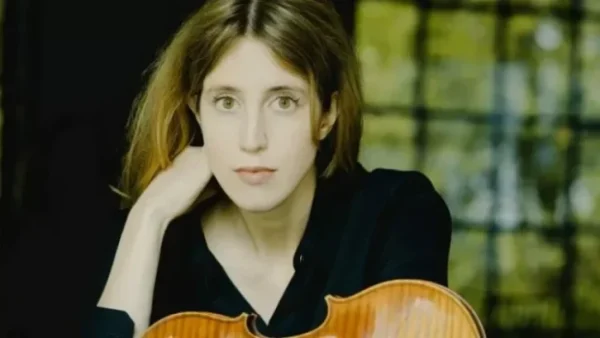 United Kingdom Norman, Stravinsky, Sibelius: Vilde Frang (violin), BBC Symphony Orchestra / Sakari Oramo (conductor). Barbican Hall, London, 20.1.2024. (CS)
United Kingdom Norman, Stravinsky, Sibelius: Vilde Frang (violin), BBC Symphony Orchestra / Sakari Oramo (conductor). Barbican Hall, London, 20.1.2024. (CS)

Andrew Norman – Unstuck
Igor Stravinsky – Violin Concerto in D major
Jean Sibelius – Symphony No.1 in E minor, Op.39
One imagines that there are few violinists, or audience members, who would claim that Stravinsky’s Violin Concerto (1931) tops their favourites list, but in this immensely engaging performance with the BBC Symphony Orchestra at the Barbican Hall, the Norwegian violinist Vilde Frang displayed tenderness for the Concerto’s quirkiness, delight in its wit and respect for its intellectual arguments. She and Sakari Oramo found much to charm, amuse and persuade the large and appreciative audience.
Frang took a middle path, emphasising neither the Concerto’s acerbic, ‘secco’ style nor adopting an overly Romantic manner à la Vengerov. There was both bite to her bowing and warmth in her tone, and a surprising lyricism at times as she explored the score’s many colours with real care and insight. The soloist rarely plays alone, but rather is often in dialogue with an orchestral instrument or section, and Frang relished such partnerships, frequently turning to engage directly with her fellow performers, her passagework part of broader musical conversations. The result was more concertante than concerto.
Though the orchestral forces look large, on paper and on the platform, they are used discriminatively by Stravinsky, with emphasis on the woodwind and brass; there’s much in the score that reminds one of the composer’s earlier neoclassical scores such as the Octet or of the Symphonies of Wind Instruments. Here, the insistent ostinatos were pungent but not overly assertive, and Oramo coaxed myriad details from his players, managing the dynamics with superb judgement, sculpting crisp, ever-changing textures, and creating an exciting dramatic canvas.
The two central movements, both described as ‘Arie’, were played with insightful expression by Frang. Neither are ‘songs’ as such – the first, in particular, presents a wry array of spiky characters, such as one might find in commedia dell’arte – but the violinist’s legato bowing and firm, intense tone brought forth the more lyrical qualities of the score. The concluding ‘Capriccio’ was spry and witty, never brittle, always gay. Frang’s vibrant upbows at the heel set the tone at the start: this was music to be enjoyed, not wrestled with. The whole performance was a marriage of musical minds and instincts.
Stravinsky may deprive the soloist of a cadenza but Frang did not deny the audience an encore, the rich rhetoric of the Giga senza basso from Antonio Maria Montanari’s Sonata in D minor proving a captivating complement to Stravinsky’s neoclassical charm.
The BBC Symphony Orchestra opened the concert with Andrew Norman’s Unstuck (2008). The composer has explained that, faced with a ‘mess of musical fragments that refused to cohere’, the memory of a sentence from Kurt Vonnegut’s novel, Slaughterhouse-Five (‘Billy Pilgrim has come unstuck in time’) helped him to overcome his writer’s block. The result is a work in which fragments and motifs ‘crop up in the wrong places’ and ‘get caught in repetitive loops’. Unstuck is an Ives-like compendium of diverse idioms and ideas, which Oramo led with an iron-secure beat and unwavering clarity. The punctuation points were strongly marked, and the tension and chromaticism accumulated, though the ultimate destination wasn’t evident to me. Indeed, the occasional stuttering and the juxtaposition of, for example, explosive tuttis and tender laments for two solo celli, seemed to drain the energy that elsewhere the score worked so hard to accrue. I’m not sure whether one is supposed to find the postmodernist, stop-start eclecticism playful or earnest, but Unstuck was played purposefully and with panache by the BBC SO.
The orchestra and Oramo have just returned from a Swiss tour during which they performed all seven of the symphonies of Jean Sibelius. Here we had the First, which Oramo conducted from memory, impressively communicating both the score’s details and its grand sweep. His trust in his players was always evident, from the opening clarinet solo over soft timpani to the two, fading pizzicato string chords that have the final say. All of Sibelius is present in this work: one hears those driving pedals, the exploitation of the darkness of the double basses, the scurrying string ostinatos that suddenly emerge from the mists into brightness, the pizzicato gestures that seem innocent but which grow into grand statements. And, more than anything, the rhythmic energies and undercurrents which are the life-force of the symphonies. Oramo got truly inside those rhythmic currents and whipped up the necessary fervour for the melodic climaxes, while making the more poised moments speak with eloquence.
The delineation of timbres and textures in the Andante (ma non troppo lento) was beautiful, the woodwind conversations invigorating and bright. There was vigour and joy in the Scherzo, and a surprising forcefulness at the start of the Finale. Throughout, as earlier in the Stravinsky Concerto, there was a sense that musical instinct and insight were working as one.
Claire Seymour
